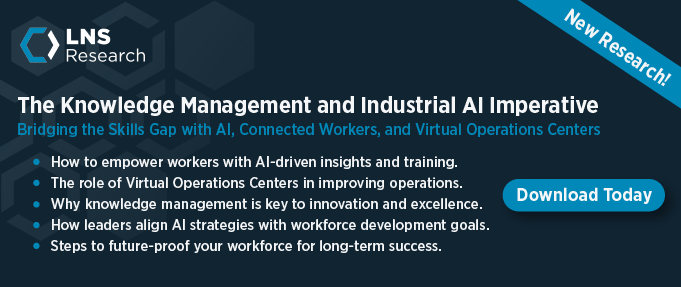Traditional Quality is failing industry today. Supply chains are stretched to the breaking point, customer preferences have shifted rapidly, and demands for sustainable manufacturing practices are on the rise in the age of environmental concerns. Despite these pressures, after widespread cost-cutting and reorganization over the past couple of years, many manufacturers are now positioned for growth.
However, that growth comes with uncertainty — from shifting trade policies and geopolitical instability to ongoing labor force disruptions. These macro-level disruptions in manufacturing are impacting performance in safety, quality, and productivity. Yet, Chief Quality Officers overwhelmingly prioritize compliance over brand protection. In fact, LNS Research data on Embedded Quality shows that Chief Quality Officers are FOUR times more likely to prioritize compliance over brand protection.
What's more, CQOs continue to prioritize compliance, even as product escapes and recalls hit their highest levels in more than five years and are trending to only escalate further. (see Figure 1)
Figure 1 — Recalls continue to escalate
Limitations of Compliance-Centric Quality Strategies
Traditionally, quality has focused on compliance, compelling others to follow defined procedures whose origin is based on some requirement or ISO-derived standard. While this approach had its merits in the Industry 3.0 days of manufacturing, it led to several critical limitations for today's industrial companies, including:
Policing Culture:
A predominant focus on compliance and procedural adherence leads to a "policing" culture where quality is equated with merely following established procedures rather than fostering a proactive quality improvement mindset.
Suppressed Flexibility:
In an environment where customer expectations and market conditions are rapidly evolving, rigid adherence to compliance stifles innovation and adaptability. Organizations prioritizing compliance over holistic quality strategies may find themselves ill-equipped to respond to emerging trends or customer feedback, ultimately jeopardizing their market position.
Fragmented Quality Initiatives:
Compliance-centric quality strategies often create silos within organizations, where quality management is disconnected from other critical functions like design, production, and customer relations. This fragmentation leads to misaligned objectives and wasted resources. A disconnected approach often results in quality issues that surface downstream rather than being addressed at their source.
Moving Toward an Embedded Quality Strategy
To address these limitations, leading organizations today are adopting a more integrated approach to quality management that encompasses various dimensions of their operations. This integrated strategy focuses on five aspects:
- Embedding Quality Across the Value Chain: An Embedded Quality approach positions quality as a shared responsibility across all departments. This collaboration ensures that every team aligns with the organization's quality goals, from research and development to supply chain and customer service. (Figure 2) Companies can enhance overall product quality and customer satisfaction by fostering interdepartmental collaboration.
- Building a Better Culture of Quality: When traditional compliance-focused quality teams attempt to create a culture of quality, they are little more than a culture of compliance. A true culture of quality elevates the company's performance and focuses the entire value chain. It is characterized by a concentration on data-based decision-making and adding value for the customer at every turn.

Figure 2 — Value Chain spanning quality strategy
- Leveraging Advanced Technologies: Integrating digital technologies into quality management practices is crucial for enhancing quality outcomes. Advanced technologies, such as Analytics and AI, can provide real-time insights into quality performance and potential issues.
- Focusing on Delivered Quality: Quality is defined through the lens of customer experience. Quality must move beyond internal efficiency metrics and prioritize Delivered Quality — that is, quality that customers perceive. This involves actively gathering and analyzing the Digital Voice of the Customer (DVoC) and integrating these insights into every stage of the product lifecycle, from product development through delivery.
- Investing in Successful New Product Launches: Product development demand is accelerating. Companies are realizing the enormous potential business benefits of successful new products in the market. Revenue is boosted as new products with better features command a higher price. Enhanced products can displace competitors, garnering additional market share, sidestepping the "shrinkflation" anathema, and addressing shifting customer preferences.
The Engineering or R&D function owns the development of new products. Still, Quality plays a significant role in informing the design teams about Digital Voice of the Customer insights (Figure 3) that help guide new product development.
To represent that quality has "skin in the game," value chain-focused quality strategies include elements for NPI Success. Quality leaders are more than 60% more likely to include a DVoC initiative in their Embedded Quality transformation, and more than 40% more likely to point it at NPI success.

Figure 3 — Digital Voice of the Customer informs product design
Recommendations for CQOs: How to Develop an Effective Embedded Quality Strategy
Chief Quality Officers (CQOs) need to shift their role from compliance enforcers to influential business partners who drive growth, innovation, and customer trust. As such, LNS Research recommends:
- Broaden Your Functional Reach
An effective Quality Strategy looks across the value chain and seeks to influence partner functions toward a positive culture of data-based decision-making and customer-focused actions.
- Anchor Quality to Enterprise Strategy
Align with partner and corporate strategies to show how quality can contribute as a valued business partner rather than a compliance policing function.
- Champion the Customer Voice
The Digital Voice of the Customer is a significant input source for new product ideas and operational excellence improvements. Own the Voice of the Customer and educate the company on it.
- Bring Suppliers to the Table
Expand beyond traditional supplier quality management to include suppliers in collaborative design work.
